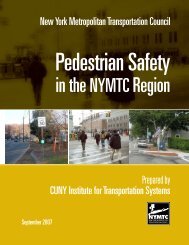<strong>Chapter</strong> 3This Genset train was purchased with CMAQ funds and is used by CSX out of the Oak Point Yard in the Bronx.8. Rail FreightHistory and geography have combinedto limit rail freight access between theNYMTC planning area and pointssouth and west (for more information onfreight please see Plan 2040: Appendix 8for the Regional Freight Plan - InterimPlan Summary Report). Six of the 10NYMTC counties are on islands east ofthe Hudson River and Arthur Kill; onlyRockland lies west of the Hudson. Whileeight vehicular bridges and tunnels spanthe Kill Van Kull and the Hudson Riverwithin the NYMTC planning area, onlythe Arthur Kill Lift Bridge brings railfreight traffic to Staten Island from thenational rail network in <strong>New</strong> Jersey andbeyond and that rail service is limited toStaten Island. In 1974 a fire closed thePoughkeepsie railroad bridge which wasthe only rail crossing between <strong>New</strong> <strong>York</strong>City and Albany. 106 Since then, to reachanyplace in the NYMTC planning areaexcept Staten Island, freight trains havetraveled north up the West side of theHudson, across the Hudson using theCastleton Cutoff, and then back downthe East side of the Hudson (sharingcommuter rail track), a detour of 240miles.East of the Hudson much the regionalrail network is primarily dedicated topassenger service. This contributes to theNYMTC planning area shipping onlyapproximately one percent of its freightby rail. However, the PANYNJ has takensteps to encourage more freight. InSeptember 2008, PANYNJ bought <strong>New</strong><strong>York</strong> <strong>New</strong> Jersey Rail LLC, a companythat transfers rail cars by barge betweenthe Greenville Yards in Jersey City andthe 65th Street Yard in Brooklyn. <strong>The</strong>Port Authority also embarked upon a$118.1 million expansion of the facilityto allow it to handle significantly highervolumes, including foodstuffs, lumberand construction materials, biodiesel,and plastics eastbound and scrap metals,autofluff, and municipal solid wastewestbound. Planned improvements includenew, larger carfloats, a replacementtransfer bridge, new locomotives, newfendering in Greenville and Brooklyn,and new supporting track. <strong>The</strong> project isprojected to take 360,000 trucks off theroad annually, freeing up space in trans-Hudson tunnels and bridges.Staten Island has also played a large partin converting truck freight to rail freight.Following the creation of ExpressRailat the <strong>New</strong> <strong>York</strong> Container Terminal innorthwest Staten Island, the terminal sawan increase from 451 containers movedby rail per month in 2007 to more than5,000 per month in 2008. Capacity forthe new facility is 100,000 containersa year. Five tracks in the facility (withplans to expand to eleven) connect to thereactivated Staten Island Railroad, whichconnects to the Conrail Main Line inElizabeth, NJ <strong>New</strong> <strong>York</strong> Economic DevelopmentCorporation, on behalf of the<strong>New</strong> <strong>York</strong> Container Terminal in StatenIsland, also received $1.55 million inorder to replace one locomotive with anew, environmentally friendly model. 107Less than one percent of freight on LongIsland is shipped by rail. 108 However, ef-<strong>The</strong> <strong>Transportation</strong> <strong>System</strong> 3-35
<strong>Chapter</strong> 3forts are being undertaken to increasethat percentage. In September 2011,Suffolk County saw its first new rail yardin Yaphank, called the Brookhaven RailTerminal. <strong>The</strong> $40 million facility acceptsrail freight, which is then transferredto trucks for local delivery. <strong>The</strong>goal of the facility is to reduce traffic andemissions from 40,000 trucks annuallyby reducing truck trips to short-haul andlocal trips originating at the terminal. 109Space at the facility exists for expansion.A restored spur off the Long Island RailRoad Main Line to the western edge ofEnterprise Park at Calverton also openedin September 2011. Future phases couldbring the spur through the business parkto connect to more businesses. 110Rail freight on Long Island is carriedby the <strong>New</strong> <strong>York</strong> & Atlantic Railway, asubsidiary of Anacostia & Pacific Company,Inc., or trucks owned by LIRR. 111In order to cut down on idling enginesin Glendale, the <strong>New</strong> <strong>York</strong> & AtlanticRailway will spend $1 million to installdevices that reduce emissions and makethe trains quieter by cutting down onidling time. 112Meanwhile, a CSX Corporation freighttrain facility situated in Middle Village,Queens will be moved to a less residentialarea, which is several hundred feetsouthwest of 69 th Street near All FaithsCemetery. <strong>The</strong> trains carry municipalsolid waste, and occasionally idle in theneighborhood. After complaints by residentsabout noise and odors, NYSDOTand CSX reached an agreement to moveand divide the facility. 113 One stagingarea will be moved closer to the All FaithsCemetery while the second staging areawill be relocated less than 500 feet fromits current location.Fourteen grade crossings will be examinedby CSX, <strong>New</strong> <strong>York</strong> State andRockland County in order to improvesafety. <strong>The</strong> $8 million project will installcrossing gates and other safety measuresto create a “Quiet Zone”; without thesegates, CSX is required by law to soundits horns as it passes through the intersection.<strong>The</strong> goal of the project is to improverail freight movement through thecounty, and also keep pedestrians anddrivers safe while improving quality oflife. 114Along with track improvements, CSXbought four Generator Set (gen-set) locomotivesfor its Oak Point Yard in theBronx using NYMTC Congestion MitigationAir Quality (CMAQ) funding.<strong>The</strong>se locomotives reduce nitrous oxideand particulate matter emissions by 80percent while also reducing carbon dioxideemissions. 115 This is part of a CSXsystemwide locomotive upgrade. Also atthe Oak Point Yard, CSX will rebuildtrack and increase clearances by usingfunds from NYSDOT. 116In June 2011, NYSDOT and the CUNYInstitute for Urban <strong>System</strong>s released itsConsideration of Potential Intermodal Sitesfor Long Island report. <strong>The</strong> documentconsiders various locations throughoutLong Island for a rail/truck freight facility.Thirteen locations were studied inboth Nassau and Suffolk counties. Criteriaranged from necessity to amount offree space to accessibility to the LIRR.Ultimately, the report recommends thePilgrim State Hospital site due to its centrallocation on Long Island, its connectionto the LIRR, and its large size. 117Another notable project is the developmentof freight villages in the NYMTCplanning area. As the volume of freightincreases in the NYMTC planning area,efforts are being made to utilize existingolder industrial sites as staging areas forimproved and more efficient distributionareas. <strong>The</strong>se areas, commonly referred toas freight villages, will include not onlythe more traditional distribution functionsbut also facilities for taking semifinishedgoods and creating customizedfinished products. This complete approachto distribution and product developmentwill promote the rational andefficient use of land, relieve traffic congestionamong freight vehicles and promoteeconomic development by increasingjob opportunities.3-36 Plan 2040: NYMTC Regional <strong>Transportation</strong> Plan
















